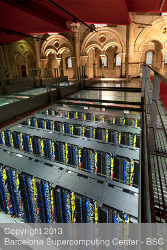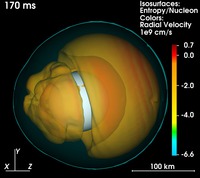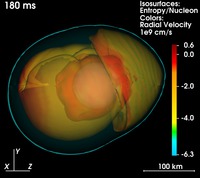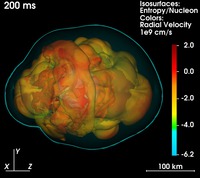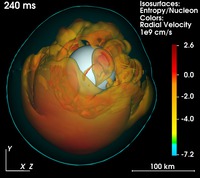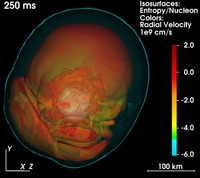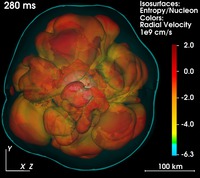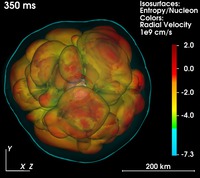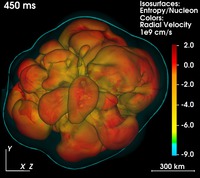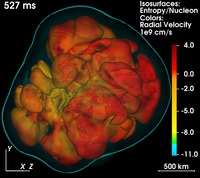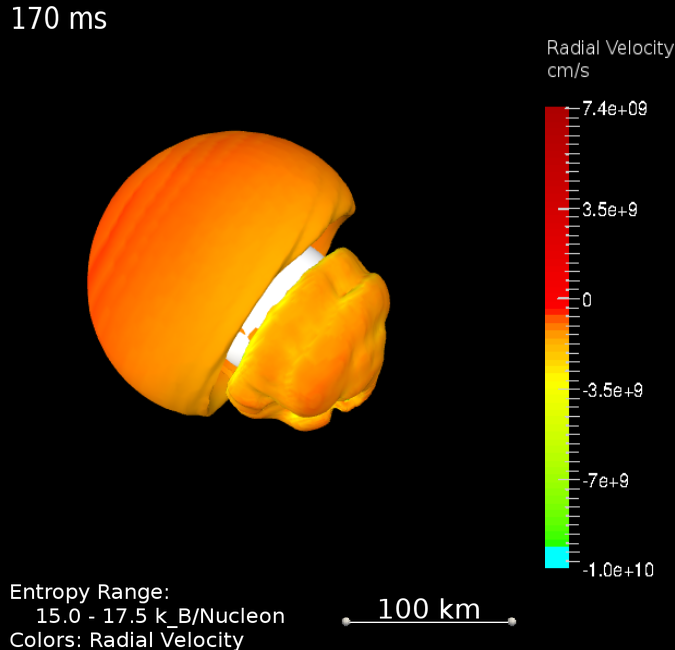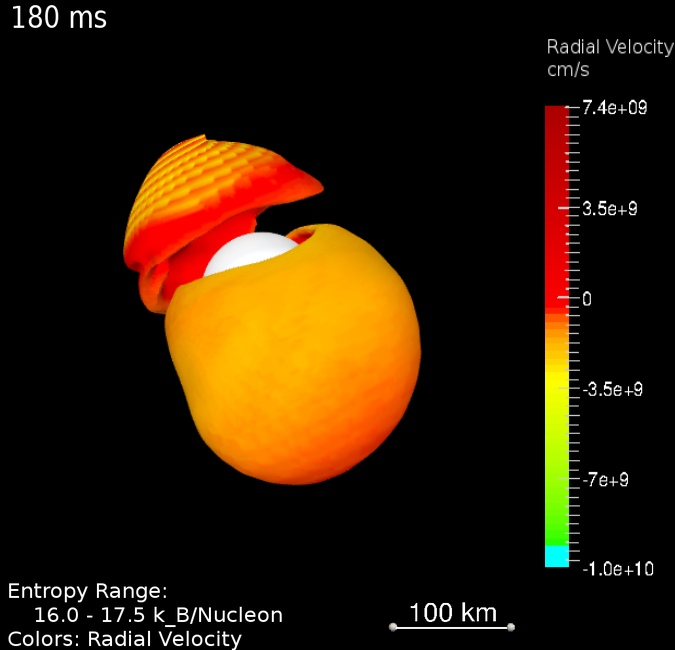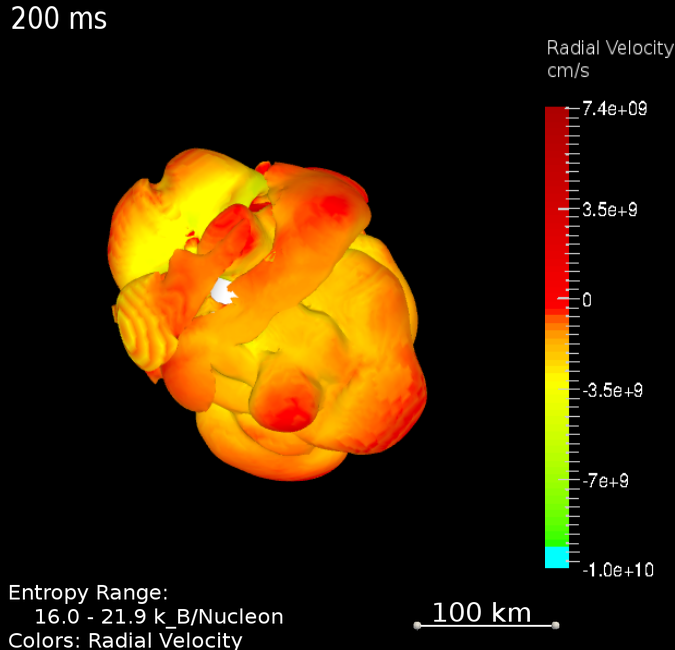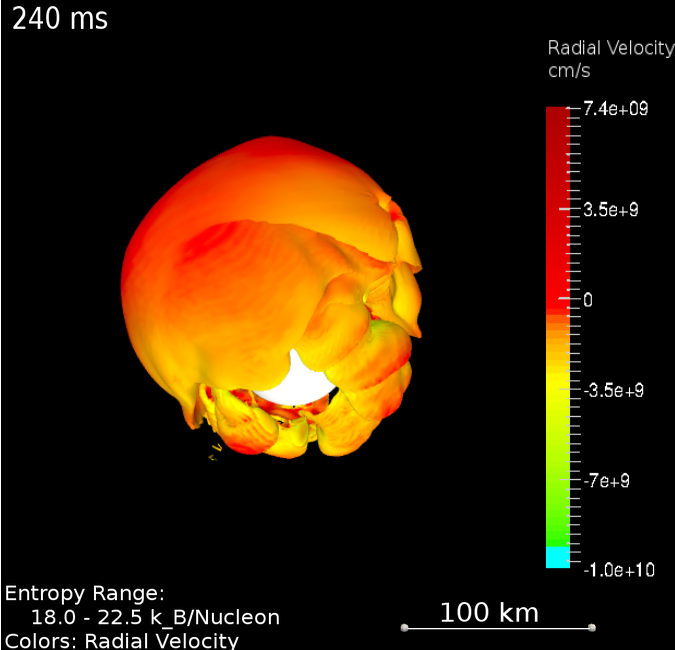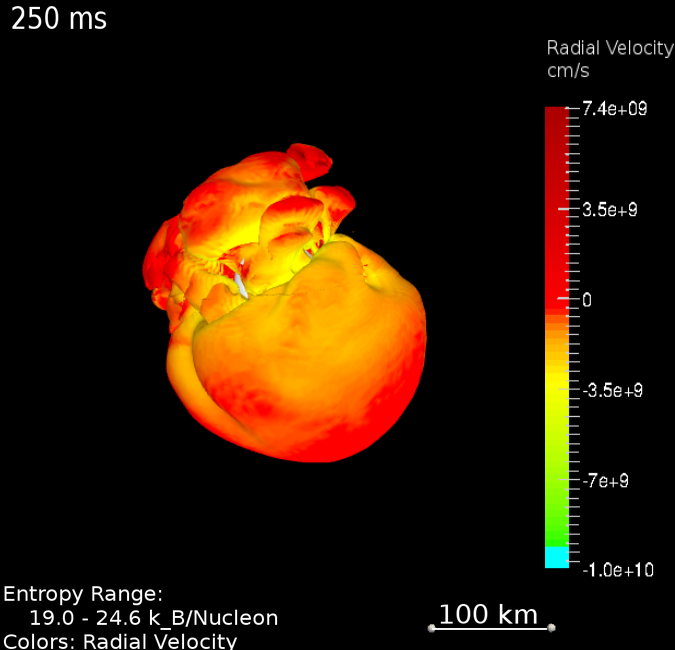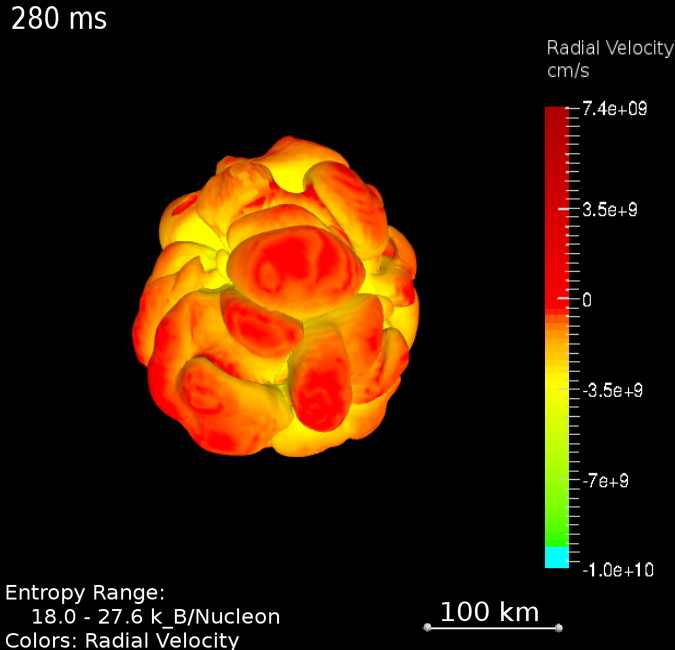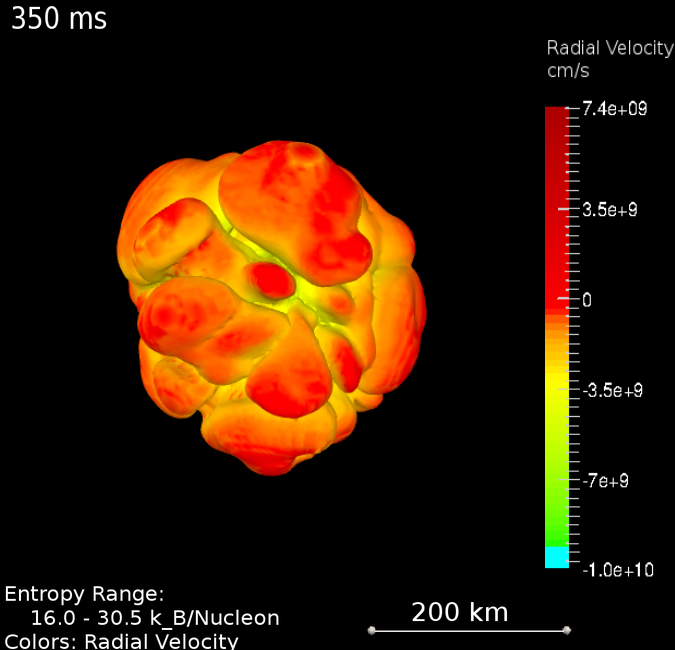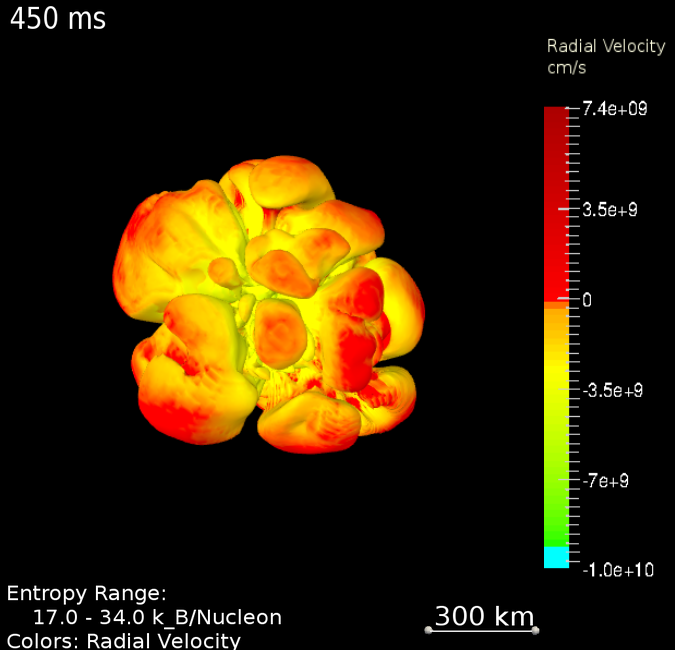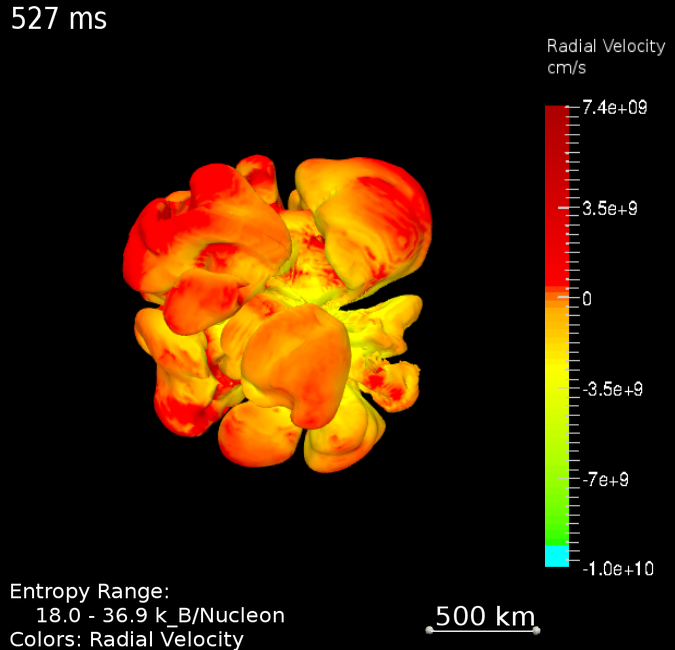Three-dimensional computer simulations support neutrinos as cause of supernova explosionsLatest three-dimensional computer simulations are closing in on the solution of an decades-old problem: how do massive stars die in gigantic supernova explosions? Since the mid-1960s, astronomers thought that neutrinos, elementary particles that are radiated in huge numbers by the newly formed neutron star, could be the ones to energize the blast wave that disrupts the star. However, only now the power of modern supercomputers has made it possible to actually demonstrate the viability of this neutrino-driven mechanism. Supernovae are among the brightest and most violent explosive events in the Universe. They are not only the birth sites of neutron stars and black holes; they also produce and disseminate heavy chemical elements up to iron and possibly even nuclear species heavier than iron, which could be forged during the explosion. Understanding the explosion mechanism of massive stars is therefore of fundamental importance to better define the role of supernovae in the cosmic cycle of matter. Stars with more than about eight times the mass of our sun evolve by "burning" nuclear fuel to successively heavier chemical elements, thus converting hydrogen to helium, carbon, oxygen, sulfur and silicon, until a dense, degenerate core mostly made of iron builds up in the center. At this stage no further energy gain by nuclear fusion is possible, because neutrons and protons in iron nuclei possess the highest nuclear binding energies.
Lacking its central energy source, the stellar iron core cannot escape gravitational instability when its mass grows to a critical limit by ongoing silicon burning in a surrounding shell. A catastrophic collapse sets in and stops abruptly only when the stellar matter reaches densities higher than in atomic nuclei. At this moment repulsive forces between the neutrons and protons resist further compression and the central region bounces back to send a strong shock wave into the overlying, still infalling matter of the iron core. For more than 30 years there had been hope that ever more improved computer models would finally be able to demonstrate that this "core-bounce shock" is able to trigger a successful supernova explosion by reversing the infall of the outer stellar layers. However, the opposite turned out to be the case: Better models showed that the energy losses of the bounce shock are so dramatic that its outward propagation comes to a halt still well inside of the iron core. It became clear that something has to help reviving the stalled shock. Some mechanism has to supply the shock with fresh energy so that it reaccelerates and expels the stellar mantle and envelope in the supernova blast.
Already in the 1960's it was speculated (in a seminal publication
by Stirling Colgate and Richard White) that neutrinos might be
involved. Myriads of these high-energy elementary particles are
radiated by the extremely hot, newly formed neutron star. If less than
one percent of them gets absorbed in the matter behind the stalled
shock, a healthy supernova explosion will be the consequence
(see
However, many aspects of the involved physics were still too crude
and too approximate to be realistic. In particular, with the
observation of Supernova 1987A it became clear that stellar
explosions are highly asymmetric phenomena and non-spherical plasma
flows must play an important role already at the very beginning
of the explosion. Early multi-dimensional computer models ---mostly
still in two dimensions, i.e., assuming rotational symmetry
around a chosen axis for reasons of computational efficiency---
indeed showed that
convection and non-radial mass motions provide crucial support to
the neutrino-heating mechanism and enhance the energy deposition
by neutrinos. Thus explosions could be obtained although spherical
models did not find shock revival and did not lead to explosions
(see Nature, however, has three spatial dimensions and therefore these early successful models were critisized to be unrealistic and not reliable. In fact, not only the assumed axial symmetry is artificial, also the physics of turbulent flows differs in two dimensions compared to the 3D case. Only very recently the increasing power of modern supercomputers has now made it possible to perform supernova simulations without artificial constraints of the symmetry. A new level of realism in such simulations is thus reached and brings us closer to the solution of a 50 year old problem. The stellar collapse group at the Max Planck Institute for Astrophysics (MPA) plays a leading role in the worldwide race for such models. With all relevant physics included, in particular using a highly complex treatment of neutrino transport and interactions, such computations are at the very limit of what is currently feasible on the biggest available computers. The model simulations are performed on 16,000 cores (equivalent to a similar number of the fastest existing PCs) in parallel, which is the largest share of SuperMUC at the Leibniz-Rechenzentrum (LRZ) in Garching (Fig. 1) and of MareNostrum at the Barcelona Supercomputing Center (BSC; Fig. 2) that the MPA team is granted access to. Nevertheless, one full supernova run, conducted over an evolution time of typically half a second, consumes up to 50 million core hours and takes more than 1/2 year of project time to be completed.
The enormous effort has payed off! The MPA team has recently
been able to report a first successful 3D explosion for a 9.6
solar-mass star (see
Further work on the theoretical models is necessary. So far the
successful 3D simulations could only be done with rather coarse
resolution, because bigger computers would be needed to perform
more refined supernova calculations.
Moreover, a wider range of stellar masses must be investigated,
varying the initial conditions in the pre-collapse cores.
A final confirmation of our theoretical picture of the explosion
mechanism and the role of neutrinos, however, can only come from
observations. On the one hand this demands a closer link of
the explosion models to observable supernova properties,
on the other hand much hope rests on a next supernova that
will occur in our Milky Way galaxy.
Such a nearby event will flood the Earth with
1030 neutrinos, of which several thousand to tens of thousands
will be captured in huge underground experiments like
Super-Kamiokande in Japan and IceCube at the South Pole.
Neutrinos (besides gravitational waves) will thus serve as
unique messengers: since they escape from the center of the
supernova they will bring us information directly from the
very heart of the explosion.
Publications:
T. Melson, H.-T. Janka, & A. Marek: Neutrino-driven supernova of a
low-mass iron-core progenitor boosted by three-dimensional
turbulent convection, Astrophysical Journal Letters, 801, L24 (2015);
e-print
T. Melson, H.-T. Janka, R. Bollig, F. Hanke, A. Marek, & B. Müller: Neutrino-driven explosion of a 20 solar-mass star in three dimensions enabled by strange-quark contributions to neutrino-nucleon scattering, Astrophysical Journal Letters, 808, L42 (2015); e-print Acknowledgments:Elena Erastova and Markus Rampp (Max Planck Computing and Data Facility (MPCDF)) are acknowledged for the images of Figs. 3 and 4, Aaron Döring for the movies of our supernova simulations. This project was partly funded by the European Research Council through grant ERC-AdG No. 341157-COCO2CASA. Computing time was kindly provided by the European PRACE Initiative on SuperMUC (GCS@LRZ, Germany) and MareNostrum (BSC, Spain). The postprocessing of the simulation data was conducted on the IBM iDataPlex System hydra of the Max Planck Computing and Data Facility (MPCDF).Contact:Dr. Hans-Thomas JankaMax Planck Institute for Astrophysics, Garching Tel.: +49 89 30000-2228 email: hjanka  mpa-garching.mpg.de mpa-garching.mpg.de
|

